

Guides and Handouts. June 2nd, 2014 Waxing Crescent Moon Clark Planetarium See Whats Out There Education Links Guides and Handouts Download the free PowerPoint viewer here.
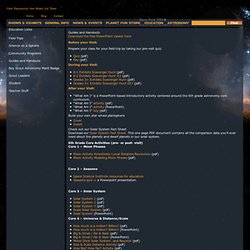
Before your Visit: Prepare your class for your field trip by taking our pre-visit quiz. ClassAction. Announcement - We normally simply add new questions to the bottom of a module to prevent the numbering associated with questions from changing.

However, rarely a complete reorganization is appropriate to group questions of a similar topic near each other or to add a large amount of new material. Please note that during May (and likely into August) of 2013, substantial revisions are being performed on the Jovian Planets (and moons) Module.Please note that during May (and likely into June) of 2013, substantial revisions are being performed on the Debris Module.Please note that during April of 2013, substantial revisions were performed on the ExtraSolarPlanets module. The Binary and Variable Stars and the Coordinates and Motions Modules were both reorganized around April of 2012. ClassAction v2 is a browser for all ClassAction questions. Teacher Resources: Astronomy at Portland Waldorf High School. Space Worksheets. Galaxies and Quasars.
About Milky Way Galaxy Worksheet - Free Printable Worksheets. The Teacher's Corner: Multidisciplinary Classroom Activities. CERES: Galaxy Classification Activity. In this inquiry activity, students view NASA images of galaxies and develop a galaxy classification scheme.
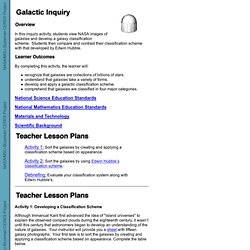
Students then compare and contrast their classification scheme with that developed by Edwin Hubble. By completing this activity, the learner will: recognize that galaxies are collections of billions of stars. understand that galaxies take a variety of forms. develop and apply a galactic classification scheme. comprehend that galaxies are classified in four major categories.National Science Education Standards National Mathematics Education Standards Materials and Technology Scientific Background Activity 1: Sort the galaxies by creating and applying a classification scheme based on appearance.Activity 2: Sort the galaxies by using Edwin Hubble’s classification scheme. The Hidden Lives of Galaxies - Classifying Galaxies. Part I Brainstorm answers to the following questions in your group.
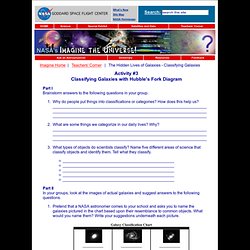
Why do people put things into classifications or categories? How does this help us? _____________________________________________________________________ _____________________________________________________________________ _____________________________________________________________________ What are some things we categorize in our daily lives? Why? _____________________________________________________________________ _____________________________________________________________________ _____________________________________________________________________ What types of objects do scientists classify? Part II In your groups, look at the images of actual galaxies and suggest answers to the following questions.
Pretend that a NASA astronomer comes to your school and asks you to name the galaxies pictured in the chart based upon their resemblance to common objects. Astro 10. In Fall 2004 I was one of 12 GSIs for Alex Filippenko's course in Introductory Astronomy (Astro 10) at U.C.
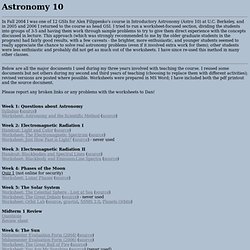
Berkeley, and in 2005 and 2006 I returned to the course as head GSI. I tried to run a worksheet-focused section, dividing the students into groups of 3-5 and having them work through sample problems to try to give them direct experience with the concepts discussed in lecture. This approach (which was strongly recommended to me by the older graduate students in the program) had fairly good results, with a few caveats - the brighter, more enthusiastic, and younger students seemed to really appreciate the chance to solve real astronomy problems (even if it involved extra work for them); other students were less enthsiastic and probably did not get as much out of the worksheets.
I have since re-used this method in many other classes. Below are all the major documents I used during my three years involved with teaching the course. Midterm 1 Review Questions Review sheet. Altaastronomy.wikispaces. Animacje, wizualizacje i mapy nieba: 1. Animacje, wizualizacje i mapy nieba: 1.

. - mapa nieba w różnych częstotliwościach, zaczynając od promieniowania rentgenowskiego, a kończąc na promieniowaniu radiowym. Animacje, wizualizacje i mapy nieba: 1. P-dog's blog: boring but important: Astronomy in-class activity: eclipses. Astronomy 210 In-class activity 5 v.13.06.09, fall semester 2013Cuesta College, San Luis Obispo, CA.
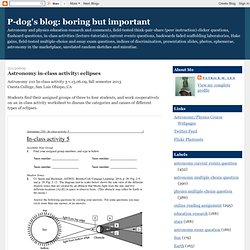
Solar System and Universe / Teachers' Corner / Education / ESA. Pomiar odległości do supernowej. P-dog's blog: boring but important. Earth Science. Index of /astronomy/education/fall04/komatsu. Parallax in the Lab. When you look at things from two different points of view, nearby objects appear to shift with respect to more distant ones.
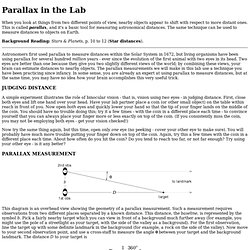
This is called parallax, and it's a basic tool for measuring astronomical distances. The same technique can be used to measure distances to objects on Earth. Background Reading: Stars & Planets, p. 10 to 12 (Star distances). Astronomers first used parallax to measure distances within the Solar System in 1672, but living organisms have been using parallax for several hundred million years - ever since the evolution of the first animal with two eyes in its head. Two eyes are better than one because they give you two slightly different views of the world; by combining these views, your brain can estimate distances to nearby objects. A simple experiment illustrates the role of binocular vision - that is, vision using two eyes - in judging distance.
Now try the same thing again, but this time, open only one eye (no peeking - cover your other eye to make sure). Astronomia w opracowaniach różnych autorów - Astronomia - metryk. Solar Stormwatch : Resources for teachers.